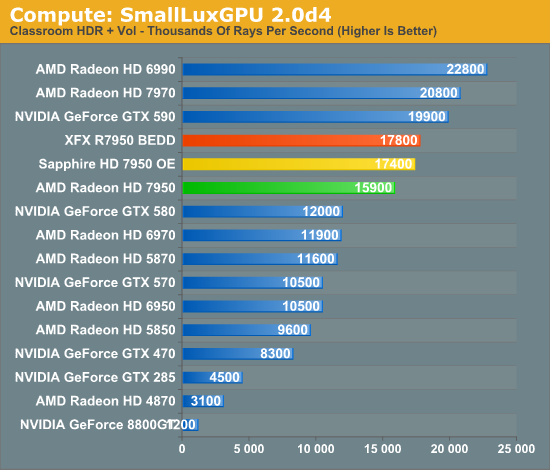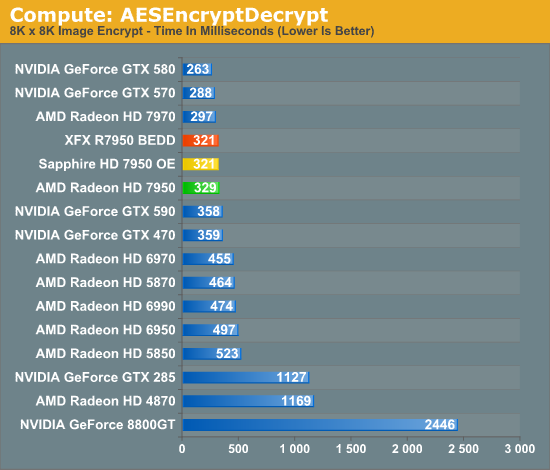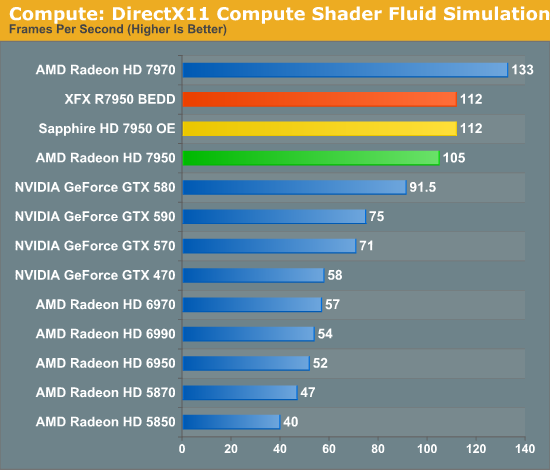AMD Radeon HD 7950 Review Feat. Sapphire & XFX: Sewing Up The High-End Market
by Ryan Smith on January 31, 2012 9:02 AM ESTCompute Performance
Moving on from our look at gaming performance, we have our customary look at compute performance. Since compute performance is by definition shader bound, the 7950 is at a bit of a disadvantage here compared to gaming performance. Whereas ROP performance scales with the core clock, shader performance is hit by both the reduction in the core clock and the disabled CU array.
Our first compute benchmark comes from Civilization V, which uses DirectCompute to decompress textures on the fly. Civ V includes a sub-benchmark that exclusively tests the speed of their texture decompression algorithm by repeatedly decompressing the textures required for one of the game’s leader scenes. Note that this is a DX11 DirectCompute benchmark.

AMD’s greatly improved compute performance continues to shine here, though in the case of Civilization V it’s largely consumed by just closing the previously large gap between the GTX 500 series and the Radeon HD 6000 series. As a result the 7950 falls ever so short of the GTX 580, while the factory overclocked Sapphire and XFX cards give the 7950 enough of a push to come within 5% of the 7970.
Our next benchmark is SmallLuxGPU, the GPU ray tracing branch of the open source LuxRender renderer. We’re now using a development build from the version 2.0 branch, and we’ve moved on to a more complex scene that hopefully will provide a greater challenge to our GPUs.

Under SmallLuxGPU the 7970 enjoyed a large lead over the GTX 580, and this continues with the 7950. Even though the 7950 is well behind the 7970—to the tune of 24%—it’s still 33% ahead of the GTX 580 and the lead only grows from there. Meanwhile the XFX and Sapphire cards can catch up to the 7970 somewhat, but as this is truly a shader-bound test, you can’t make up for the lack of shaders units on the 7950.
For our next benchmark we’re looking at AESEncryptDecrypt, an OpenCL AES encryption routine that AES encrypts/decrypts an 8K x 8K pixel square image file. The results of this benchmark are the average time to encrypt the image over a number of iterations of the AES cypher.

In spite of being a compute benchmark, AESEncryptDecrypt is not particularly sensitive to GPU performance, showcasing the impact that setup times can have. The 7950 trails the 7970 by 10%, and overclocking doesn’t change this much. Unfortunately for AMD NVIDIA is still the leader here, showing that AMD’s compute performance still has room to grow.
Finally, our last benchmark is once again looking at compute shader performance, this time through the Fluid simulation sample in the DirectX SDK. This program simulates the motion and interactions of a 16k particle fluid using a compute shader, with a choice of several different algorithms. In this case we’re using an (O)n^2 nearest neighbor method that is optimized by using shared memory to cache data.

With the compute shader fluid simulation we once again shift back into a compute task that’s much more shader-bound. The 7950 only reaches 80% of the performance of the 7970, once more proving the real impact of losing a CU array. This is still enough to handily surpass the GTX 580 however, with the 7950 taking a 15% lead.










259 Comments
View All Comments
chizow - Tuesday, January 31, 2012 - link
Now it starts to become obvious why people shouldn't be doing cartwheels in the streets over Southern Islands. Its a nice chip, it really is. But the problem with its pricing just became even more obvious with the 7950 as AMD is selling you yesterday's performance at next-gen prices. In other words, if you wanted this level of performance, you could've gotten it a year ago with the GTX 580 for almost the same price....over a year ago....And that's why AMD's pricing of these parts fails. With the 7950 it all comes into focus and if it wasn't clear before, it will become crystal once Kepler drives the nail home when it launches at its expected prices and performance levels. What's left for AMD to launch? A 7870 that's as fast as the 6970 but costs $50 more? A 7850 that's as fast as the 6950 but costs $75 more? Do we really think Nvidia is going to launch a 580 equivalent at 28nm and price it at $450? See how it all comes into focus?
But Nvidia really has a chance to return the favor to AMD here with a pricing debacle of GTX 260/280-esque proportions. If GK104 comes within spitting distance of the 7970 or even 7950 at $300, AMD is going to look really bad. If GK110 beats the 7970 by 20-25% and costs only $500, AMD execs will be jumping out of windows. We're talking about issuing rebate checks that AMD can't afford to write on every 7950/7970 sold at these ridiculous prices for however many months it takes until Nvidia releases Kepler.
Goty - Tuesday, January 31, 2012 - link
1) I believe you mean "consistently faster than last-gen performance for the same price", which is how it will remain until NVIDIA gets a card out that can compete.and
2) Keep dreaming.
chizow - Tuesday, January 31, 2012 - link
1) Well the good news is Nvidia decided to compete over a year ago when they launched the GTX 580. At these prices AMD has set, Nvidia is still amazingly competing with their 14 month old last-gen parts.and
2) The better news is AMD has set the bar extremely low for Nvidia. Should be easy pickings for Kepler.
halo37253 - Tuesday, January 31, 2012 - link
Yet a overclocked 7970 is about as fast as a gtx590, yeah... nvidia sure is competing. lolReally there is no reason to get a nvidia card right now, with the gtx580 and its continuing high costs not even able to hold its own again even a 7950. Once the 7xx series launches I can see AMD launching the hd89xx series no to long after with XDR2 memory and higher clocked cores.
For overall performance per watt it seems AMD cant be touched right now.
kashifme21 - Tuesday, January 31, 2012 - link
The real question is, Do we really need these upgrades anymore. I mean todays games barely push tech. Most of my friends are happy with their 5870's and GTX 480's we bought about 2 years backThing is games are designed with consoles in mind and with next gen console hardware rumors to be around the level of 6670 GPUs, why would anyone upgrade anymore, unless they intend to be running multiple screens.
I personally run GTX 580 SLI. I think i personally wont be upgrading until i see a game that actually stresses my system in eyefinity settings.
Its a sad state but many games recently released dont even support freatures like AA or even any pc options, games are rather straight console ports, with PC as an after thought. Why buy such expensive hardware for ports?
jleach1 - Tuesday, January 31, 2012 - link
I agree. Even my 5850 hasn't stressed much in recent games...and I bought it for 280 USD a couple years ago.Performance per dollars, and temp per dollar, AMD is on target, more often than not....now, if only we could get the FX sorted out...
I used to buy nvidia cards, but haven't since the 5000 series, and it looks to continue this way.
The moral is, competition is ultimately what brings prices down and motivation to up the performance.
I hope AMD can throw out something cool soon on the CPU side, because while I always have, and likely will continue to buy Intel, I love the competition. Sorry, I sorta gave up on AMD after the i7-930 came out. But that doesn't mean I'm not rooting for them...even if it is only for the sake of competition.
TerdFerguson - Tuesday, January 31, 2012 - link
On the other hand, upgrading the 5850 that you've had for several years is going to require you to jump to a /higher/ price tier. That's insanity. If that kind of pricing structure existed for ANY other consumer electronics product, people would be vocally antagonistic. AMD deserves some antagonism.JonnyDough - Wednesday, February 1, 2012 - link
I disagree. Supply and demand. They don't have the supply and there's a big enough demand to keep prices inflated. Nobody can be upset at all about the prices. If you don't like them, don't buy the product. It's that simple. Capitalism fails us often, but here's a case where it works just fine. :)TerdFerguson - Wednesday, February 1, 2012 - link
By your foolish reasoning, AMD would be in top form if it produced and sold just a couple of hand-crafted units each quarter. That they can't meet volume demand is a failing, not a benefit.artk2219 - Wednesday, February 1, 2012 - link
I've got to say that I agree with JohnnyDough, in the short term keeping prices high and making a killing off of each card sold is a good thing for AMD, not so great for us consumers but again, its not like anyone is forcing you to buy it. However you are correct in that in the long term that is a failing strategy for a company like AMD, its not like they're making luxury sports cars :). Either way it makes no difference to me and it puts them in a great position for a coming price war with Nvidia and Kepler which will inevitably be faster, I just hope Nvidia does something about their power profile.